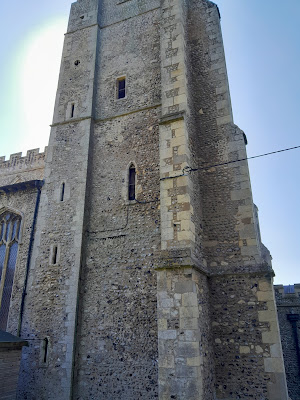What strikes you about St Margaret's in Cley Next the Sea, is how unlike any other parish church along the North Norfolk coast it is. Beautifully and richly ornamented architecturally, this sort of work does not come cheap. They had royal and noble patronage, but why here, in what is now a small village?
It's hard to imagine Cley as a major English port, that had a close trading relationship with the German Hanseatic League. Norfolk in medieval times was one of the wealthiest areas of England, due to the economic dominance of East Anglian wool and weaving. Cley exploited access to this market.
The quality, size and age of the many substantial buildings in Cley. betrays this rich trading history. The era when numerous large boats would be in the harbour, plus a thriving port area just at the bottom of the current churchyard.
The main channel allowing access to the port, did over the centuries begin to silt up. This forced the ports harbour to move nearer to the sea where the channel remained broader. That silting up process was further accelerated by a local landowner embanking and enclosing surrounding land. There was also a major fire in 1612 that destroyed much of the original medieval port buildings.This is why we now find St Margaret's at the far end of a small village, with little building surrounding it to indicate its former centrality to a port.
So this is where the money came from to fund the expansion and decoration of its central religious building. Take a close look at its highly decorated porch, and the clerestory with its alternating gothic pointed and quintrefoil circular windows. These are much larger than is usual with beautifully executed ornate tracery. The church originally had two elegant side transepts that have since fallen into ruin. Probably this ruination parralleled the decline of Cley. With no money available to execute repairs. It was at one time more widespread, but there has been extensive restoration work in the late 19th century.
The church tower was originally quite squat. Its current place is to one side of the current nave. So most likely there was an earlier narrower church preceding its expansion in the 14th-15th century to the current size and style. There are filled in romanesque shaped apertures on two sides of the tower. This suggests the age of that earlier church is most likely to have been 12th Century.
The large clear glass perpendicular style windows with coloured borders, look very like Victorian replacements. As is the current Chancel, apart from a piscina and sedilia that are likely medieval. The height and light of the nave is elegant and spacious. Before the Reformation figures of saints would have adorned the ornate canopied plinths above each pillar. There are two remaining blocked up doorways to the left of the Chancel arch, that used to lead to the gallery of a medieval rood loft.
Cley is then a deceptive church. From the outside it appears relatively small in length. Only when you enter do you experience how broad and high it actually is. The glory of what it must have looked liked at its height in the 15th century, still suggested by what remains.









No comments:
Post a Comment